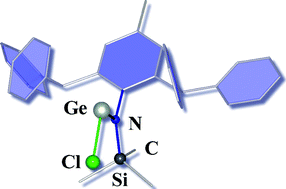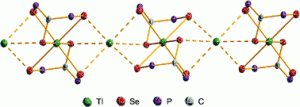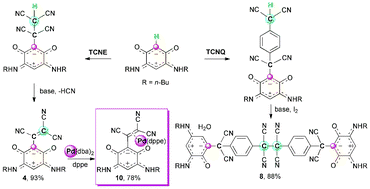 In this HOT article, a detailed study of the impact of a Jahn-Teller distorted Cu(II) ion in the anti-ferromagnetically coupled ring, Cr7Cu, is reported. The Jahn-Teller distortions are identified using spectroscopic techniques and a theoretical characterization is also presented. The problem is important for molecular magnetism as the origin of Jahn-Teller related magnetic anisotropy and consequently the barrier for the spin reversal is single molecular magnets.
In this HOT article, a detailed study of the impact of a Jahn-Teller distorted Cu(II) ion in the anti-ferromagnetically coupled ring, Cr7Cu, is reported. The Jahn-Teller distortions are identified using spectroscopic techniques and a theoretical characterization is also presented. The problem is important for molecular magnetism as the origin of Jahn-Teller related magnetic anisotropy and consequently the barrier for the spin reversal is single molecular magnets.
Read more about these interesting magnetic effects for FREE at:
Modification of the magnetic properties of a heterometallic wheel by inclusion of a Jahn–Teller distorted Cu(II) ion
Michael L. Baker, Stergios Piligkos, Alberto Bianchi, Stefano Carretta, David Collison, Joseph J. W. McDouall, Eric J. L. McInnes, Hannu Mutka, Grigore A. Timco, Floriana Tuna, Prabha Vadivelu, Høgni Weihe, Hans U. Güdel and Richard E. P. Winpenny
Dalton Trans., 2011, Advance Article
DOI: 10.1039/C1DT10547G












 In this Dalton Transactions Hot article Yu Gong and Lester Andrews from the University of Virgina, USA, look at how laser-ablated thorium and uranium react with dimethyl ether molecules.
In this Dalton Transactions Hot article Yu Gong and Lester Andrews from the University of Virgina, USA, look at how laser-ablated thorium and uranium react with dimethyl ether molecules.

 This Dalton Transactions Hot article investigates the intermolecular hydroamination of heteroatom-substituted allenes.
This Dalton Transactions Hot article investigates the intermolecular hydroamination of heteroatom-substituted allenes. In this HOT article, Ribas and co-workers build on previous studies on the mechanism of Ullmann cross coupling reactions using a well-defined aryl-copper(III) complex. Fundamental mechanistic knowledge of these couplings is still scarce but is gaining renewed interest due to the cost and toxicity benefits in comparison to Pd-based methodologies for the synthesis of key intermediates in the pharmaceutical industry. The reactivity of well defined aryl–CuIII species in front of phenol-type nucleophiles was found to differ substantially from the reactivity with corresponding phenolates, and a significant enhancement was found to produce the same aryl–O coupling product. Mechanistic studies showed that easy deprotonation of coordinated secondary amines was responsible for the intense LMCT band at 545 nm; indeed, this pH-dependent reactivity of the pincer-like coordinated ligand somewhat enhanced its reactivity.
In this HOT article, Ribas and co-workers build on previous studies on the mechanism of Ullmann cross coupling reactions using a well-defined aryl-copper(III) complex. Fundamental mechanistic knowledge of these couplings is still scarce but is gaining renewed interest due to the cost and toxicity benefits in comparison to Pd-based methodologies for the synthesis of key intermediates in the pharmaceutical industry. The reactivity of well defined aryl–CuIII species in front of phenol-type nucleophiles was found to differ substantially from the reactivity with corresponding phenolates, and a significant enhancement was found to produce the same aryl–O coupling product. Mechanistic studies showed that easy deprotonation of coordinated secondary amines was responsible for the intense LMCT band at 545 nm; indeed, this pH-dependent reactivity of the pincer-like coordinated ligand somewhat enhanced its reactivity. In this HOT article, a detailed study of the impact of a Jahn-Teller distorted Cu(II) ion in the anti-ferromagnetically coupled ring, Cr7Cu, is reported. The Jahn-Teller distortions are identified using spectroscopic techniques and a theoretical characterization is also presented. The problem is important for molecular magnetism as the origin of Jahn-Teller related magnetic anisotropy and consequently the barrier for the spin reversal is single molecular magnets.
In this HOT article, a detailed study of the impact of a Jahn-Teller distorted Cu(II) ion in the anti-ferromagnetically coupled ring, Cr7Cu, is reported. The Jahn-Teller distortions are identified using spectroscopic techniques and a theoretical characterization is also presented. The problem is important for molecular magnetism as the origin of Jahn-Teller related magnetic anisotropy and consequently the barrier for the spin reversal is single molecular magnets. This Dalton Transactions Hot article looks at the use of zinc complexes in cancer treatment. This exciting compound, made by Soumitra Choudhuri and colleagues, was found to act against drug resistant cancers.
This Dalton Transactions Hot article looks at the use of zinc complexes in cancer treatment. This exciting compound, made by Soumitra Choudhuri and colleagues, was found to act against drug resistant cancers.
